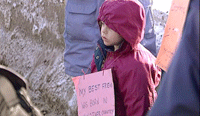In December 1992, the US-proposed Operation: Restore Hope sought to secure Somalia’s food supply from warring factions through the deployment of security forces in conjunction with the ongoing UN humanitarian campaign to control the widespread crisis of the man-made famine – a volatile situation that soon became increasingly encumbered with the greater problem of controlling civil violence throughout the unstable country. Subsequently, in June 1993, a team of Pakistani UN soldiers were massacred during routine inspections, an ambush that was believed to have been engineered by one of the country’s most powerful warlords, General Mohamed Farah Aidid. The tragedy inevitably led to the Battle of Mogadishu – the violent conflict depicted in Black Hawk Down – as the military sought to apprehend the elusive Aidid. Ten years later, the obfuscated – and increasingly mired – humanitarian crisis would seemingly converge in the traditionally Franco-American New England town of Lewiston, Maine: a community that continues to mourn a fallen son from the fateful battle with a commemorative placard on a state highway and whose wounds were recently re-opened not only by the Ridley Scott film, but further exacerbated by the uncertainty of life in immediate post 9/11 America as a large influx of Muslim-faith Somali immigrants began to settle in the town coincidentally after the terror attacks in what the media dubbed as the “Somali Invasion” of Lewiston. With the city still recovering from the downturn in the economy (caused in part by the manufacturing slowdown in the local mills and the nationwide recession), and the potential of another 1000 Somalis imminently relocating into the area (effectively doubling the ethnic Somali population), the mayor, Laurier T. Raymond Jr. penned a brusque open letter to the Somali elders urging them to use their influence within the extended ethnic community to discourage their families, friends, and native countrymen from similarly moving into Lewiston and further taxing the city’s increasingly burdened resources. Emboldened by Raymond’s controversial public appeal – and implicitly, the contingent of Lewiston residents who support a similar, intolerant (if not overtly racist) view – hate groups such as the World Church of the Creator began to descend on the town in order to further their own agenda, culminating in a planned rally on January 11 (a date perhaps selected for its fear-mongering evocation of 9/11). Growing increasingly weary of the simplistic, caricatured media portrayal of Lewiston as a haven for xenophobic, unenlightened bigots, members of the community decided to stage their own unity march despite the unapologetic (and perhaps, willful) announced absence of the mayor from the heavily media-scrutinized event (citing pre-arranged vacation plans) in a sincere and defiant gesture of humanity and plea for tolerance. Filmmaker Ziad Hamzeh’s articulate and incisive documentary, The Letter, is a thoughtful examination of the interplay between entrenched sociology and overarching cultural and historical dynamics that inexorably converge and perpetuate the legacy of hate and exclusion. Contrasting the overly rehearsed diatribes and instinctive, underformed, stereotypical arguments of the detractors against the impassioned voices of a rended town struggling to move forward in the aftermath of uncertainty and profound cultural change, the film serves as a provocative cautionary tale on intolerance, scapegoating, and myopic vision, and a compelling portrait of the human imperative for empathy and solidarity.
© Acquarello 2005. All rights reserved.
